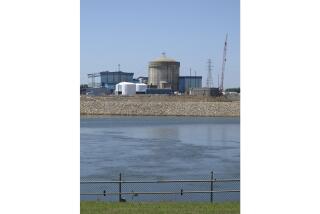Surprising Nuclear Safeguard Found in 1979 Accident : Three Mile Island: Molten fuel cooled to solid form by water is credited with averting a greater catastrophe.
- Share via
MIDDLETOWN, Pa. — Molten nuclear fuel cooled to a solid by water surprisingly provided a safeguard against a greater catastrophe during the 1979 accident at the Three Mile Island nuclear plant, a recent study asserts.
When molten uranium and other metals first flowed to the bottom of the reactor, they formed a ceramic crust that acted as an insulator. Scientists think pathways carrying water opened between the crust and the steel wall of the reactor and in a mass of molten fuel above the crust.
The water and solid fuel prevented the uranium from melting through the vessel and falling to the floor of the containment building, a situation that would have complicated the cleanup further.
“The molten fuel had a very important protective capability. That’s news,” said Eric S. Beckjord, a research director for the U.S. Nuclear Regulatory Commission who wrote a paper analyzing the report.
Eleven major industrial nations formed a consortium in 1988 and spent $9 million on the TMI Vessel Investigation Project to determine why the steel reactor vessel didn’t fail despite being subjected to searing temperatures.
Samples were taken from the vessel in 1990; a report was issued last October. Details are working their way through the scientific community.
The report dramatically confirmed the theory that water can stop molten fuel from breaching a steel reactor vessel, said Steve Sholly, a senior consultant with MHB Technical Associates of San Jose, Calif., who was not connected to the study.
If all water had been lost, the reactor vessel probably would have failed, Sholly added.
But people should not conclude that reactor vessels are a lot stronger than once believed, said Jim Riccio, an attorney with the Public Citizen Critical Mass Energy Project. The federal Nuclear Regulatory Commission doesn’t really know how brittle reactor vessels have become because of radiation over long periods, he said.
Robert Pollard of the Union of Concerned Scientists, which is often critical of the nuclear industry, said he had not seen the report and could not comment.
During the accident, the worst ever at a U.S. nuclear power plant, the upper two-thirds of the 12-foot- high reactor core was destroyed when mechanical failure and human error allowed it to lose its cooling shield of water.
Over a two-minute period, nearly 20 tons of molten fuel and debris flowed to the vessel’s bottom.
According to a fictional scenario made popular by the movie, “The China Syndrome,” which was playing at area theaters when the TMI accident occurred, melting nuclear fuel would burn its way through the bottom of anything built to contain it and sink deep into the ground, releasing deadly radiation.
A hot spot of more than 2,000 degrees did form in the steel wall at a point where the crust was thin. Previous studies said the heat should have spread to the rest of the vessel and triggered a failure, but the water cooled it within 30 minutes. Steel melts at 2,642 degrees.
Scientists had expected the molten mass to sit tightly against the vessel wall and melt through it.
“I was personally surprised,” said Mansur A. Alammar, senior engineer for the TMI operating company, GPU Nuclear Corp., and a chairman of a nuclear industry study group on the accident. “I always predicted vessel failure. Now we see this mechanism.”
Even before the new study, scientists believed the “China syndrome” was more Hollywood plot line than scientific reality.
Besides the insulating property of the fuel and the strength of the steel vessel, previous studies had shown the concrete bases on which U.S. reactors are built also would hold up against melting fuel, Beckjord said.
He said scientists will further examine the cooling process and try to determine if it would happen again in another accident.
Sholly declined to predict the effect of the report on future reactor designs. But he said some designs already incorporate safeguards that the new study indicates will be effective, such as putting reactor vessels into cavities that can be completely flooded in an accident.
More to Read
Sign up for Essential California
The most important California stories and recommendations in your inbox every morning.
You may occasionally receive promotional content from the Los Angeles Times.










